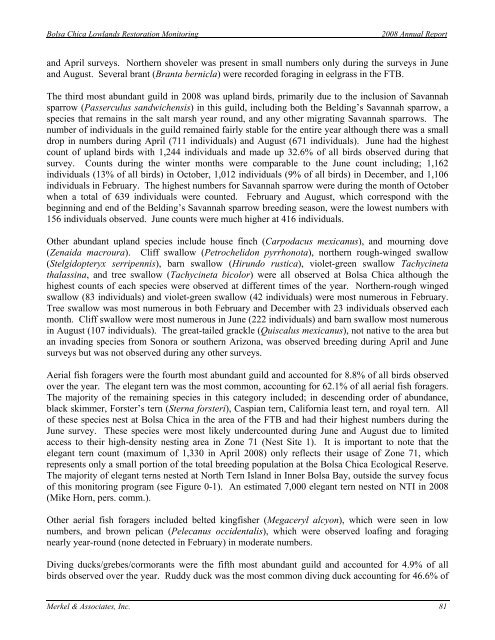2008 Annual Monitoring Report (pdf 10.9MB) - Bolsa Chica ...
2008 Annual Monitoring Report (pdf 10.9MB) - Bolsa Chica ...
2008 Annual Monitoring Report (pdf 10.9MB) - Bolsa Chica ...
You also want an ePaper? Increase the reach of your titles
YUMPU automatically turns print PDFs into web optimized ePapers that Google loves.
<strong>Bolsa</strong> <strong>Chica</strong> Lowlands Restoration <strong>Monitoring</strong><br />
<strong>2008</strong> <strong>Annual</strong> <strong>Report</strong><br />
and April surveys. Northern shoveler was present in small numbers only during the surveys in June<br />
and August. Several brant (Branta bernicla) were recorded foraging in eelgrass in the FTB.<br />
The third most abundant guild in <strong>2008</strong> was upland birds, primarily due to the inclusion of Savannah<br />
sparrow (Passerculus sandwichensis) in this guild, including both the Belding’s Savannah sparrow, a<br />
species that remains in the salt marsh year round, and any other migrating Savannah sparrows. The<br />
number of individuals in the guild remained fairly stable for the entire year although there was a small<br />
drop in numbers during April (711 individuals) and August (671 individuals). June had the highest<br />
count of upland birds with 1,244 individuals and made up 32.6% of all birds observed during that<br />
survey. Counts during the winter months were comparable to the June count including; 1,162<br />
individuals (13% of all birds) in October, 1,012 individuals (9% of all birds) in December, and 1,106<br />
individuals in February. The highest numbers for Savannah sparrow were during the month of October<br />
when a total of 639 individuals were counted. February and August, which correspond with the<br />
beginning and end of the Belding’s Savannah sparrow breeding season, were the lowest numbers with<br />
156 individuals observed. June counts were much higher at 416 individuals.<br />
Other abundant upland species include house finch (Carpodacus mexicanus), and mourning dove<br />
(Zenaida macroura). Cliff swallow (Petrochelidon pyrrhonota), northern rough-winged swallow<br />
(Stelgidopteryx serripennis), barn swallow (Hirundo rustica), violet-green swallow Tachycineta<br />
thalassina, and tree swallow (Tachycineta bicolor) were all observed at <strong>Bolsa</strong> <strong>Chica</strong> although the<br />
highest counts of each species were observed at different times of the year. Northern-rough winged<br />
swallow (83 individuals) and violet-green swallow (42 individuals) were most numerous in February.<br />
Tree swallow was most numerous in both February and December with 23 individuals observed each<br />
month. Cliff swallow were most numerous in June (222 individuals) and barn swallow most numerous<br />
in August (107 individuals). The great-tailed grackle (Quiscalus mexicanus), not native to the area but<br />
an invading species from Sonora or southern Arizona, was observed breeding during April and June<br />
surveys but was not observed during any other surveys.<br />
Aerial fish foragers were the fourth most abundant guild and accounted for 8.8% of all birds observed<br />
over the year. The elegant tern was the most common, accounting for 62.1% of all aerial fish foragers.<br />
The majority of the remaining species in this category included; in descending order of abundance,<br />
black skimmer, Forster’s tern (Sterna forsteri), Caspian tern, California least tern, and royal tern. All<br />
of these species nest at <strong>Bolsa</strong> <strong>Chica</strong> in the area of the FTB and had their highest numbers during the<br />
June survey. These species were most likely undercounted during June and August due to limited<br />
access to their high-density nesting area in Zone 71 (Nest Site 1). It is important to note that the<br />
elegant tern count (maximum of 1,330 in April <strong>2008</strong>) only reflects their usage of Zone 71, which<br />
represents only a small portion of the total breeding population at the <strong>Bolsa</strong> <strong>Chica</strong> Ecological Reserve.<br />
The majority of elegant terns nested at North Tern Island in Inner <strong>Bolsa</strong> Bay, outside the survey focus<br />
of this monitoring program (see Figure 0-1). An estimated 7,000 elegant tern nested on NTI in <strong>2008</strong><br />
(Mike Horn, pers. comm.).<br />
Other aerial fish foragers included belted kingfisher (Megaceryl alcyon), which were seen in low<br />
numbers, and brown pelican (Pelecanus occidentalis), which were observed loafing and foraging<br />
nearly year-round (none detected in February) in moderate numbers.<br />
Diving ducks/grebes/cormorants were the fifth most abundant guild and accounted for 4.9% of all<br />
birds observed over the year. Ruddy duck was the most common diving duck accounting for 46.6% of<br />
Merkel & Associates, Inc. 81






